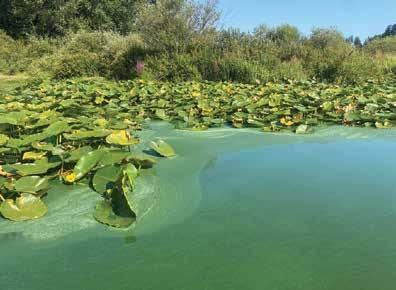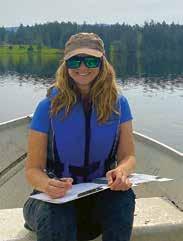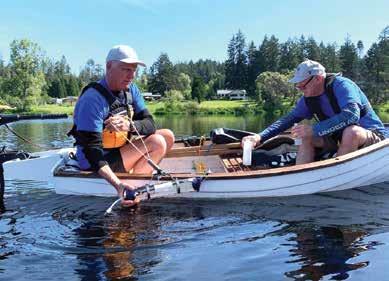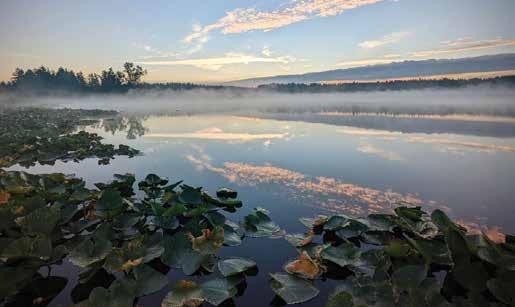
9 minute read
Are the Lakes Dying?
BY FRANCESCA PACCHIANO
The summer sun is at its hottest now, and trips to the lake are a daily occurrence. The water, once you get out past the throng of children, is cool, clear and the perfect refreshment on days like these.
But not all our lakes have been treated equally. Michael Lake, a small lake in Yellow Point, bordered by farmland and the Wildwood ecological park, has locals concerned about the impact of humans on these natural freshwater resources.
Ben Maartman, the director of Area H for the CVRD, has lived on the lake for several decades. “It’s more of a nature reserve than an active lake for people,” he said.
Despite looking unchanged and tranquil from the surface, the lake is consistently changing for the worse. “The Ministry of Environment comes down every five years, and we’ll get the occasional visit from the VIU biology program, and they tell me that on the surface it looks about the same, but the bottom is actually rising. Silt builds up from the bottom up, and as that happens, it chokes off the oxygen supply, which limits the aquatic animals’ [ability to] flourish.”
As these changes continue, the lake will eventually lose all ability to sustain fish and other aquatic life.
Fish kills and algae blooms are becoming a common occurrence at Somenos Lake in North Cowichan. Last August, fish died off in the thousands due to a sudden drop of oxygen in the water. This dramatic shift is causing anxiety for both locals and researchers alike.
Gina Hoar, aquatic biologist working with the Somenos Marsh Wildlife Society (SMWS), spoke about the pattern she has been noticing in the lake. “When algae bloom, they create a lot of oxygen, but when they all die off, the oxygen in the lake just tanks down to nothing. Then you get your fish kills.”

Gina’s work over the last four years has been to study the lake and track the data so that a plan can be made. Over the last couple years, they have tracked nitrogen, dissolved oxygen, the pH acidity of the water and the temperature, and now they’re focusing on phosphorus.
“It all circles back to what’s happening with the phosphorus in the lake. Is it coming down from the tributaries? Is it building up in the sediment at the bottom? How much is there? And so we’re doing a budget to see how much is building up over time because that’s what the algae are feeding on. If you can reduce the phosphorus that’s coming in, you can potentially reduce the algae blooms themselves, which could, in turn, reduce the amount of fish kills that are occurring.”
The SMWS is in talks with the Department of Fisheries and Oceans in regards to putting a plan in place, but currently they’re just concerned with monitoring. In order for a trend to be documented, the municipality requires a minimum of three years of data.
“At the end of the three years, we’ll do the calculations to figure out how much phosphorus is in the system [and] how much is leaving the system. Then the next steps will be [finding] the solution.”
Ches Piercy and the Quennell Lake Watershed Stewardship Society are also waiting on a solution to fix Quennell Lake. The society was originally concerned about the possible contaminants from a nearby cannabis farm. While those concerns turned out to be unfounded, the group began to notice the large algae blooms on the water. “You never really see the bottom. There’s lots of algae as the season goes on. The algae builds, and it goes in waves.”
Over the last five years, Ches and the society members have sampled five sites with three levels of testing. The first level of testing looks at water temperature and the clarity of the water. The second level measures water temperature, conductivity and oxygen. Level three is the research the Ministry of Environment is interested in. “We do all of the above [levels one and two testing] plus we collect water samples.”
Testing on the lake isn’t new. Research exists from the mid 90s, but the data collected by his team is the most current and thorough record. He took on the challenging task of compiling the last three years’ worth of data into document form, which has been published in PDF formats. These documents have been given to BC Lakes, and Ches personally received a word of Merit for outstanding report documentation because of it.
The problem is, there’s nothing conclusive about the data. Even though there are times of year when the water can be harmful to swimmers, locals advise against eating fish from the lake, and water temperatures rise beyond what can sustain fish life, there isn’t conclusive data pointing to a problem. Even worse, there’s no evident solution either.
Acquiring the data is hard work. It’s long days of calibrating equipment and being out at specific time intervals in the morning and afternoon. After five years of work, the group, who are all in their 70s, are retiring.

“We really enjoyed being on the lake, [but] it was a lot of effort to get the data for the ministry. … We got five years of data, and there’s no conclusion about the lake or any information.”
Ches hopes that their research might help a future project, but he doesn’t know who or when. “Some universities might use the data or the ministry when they get a budget to look at gathering data.” As for more immediate results, their data was well received by BC Lakes. “They were super excited, and we have been promised a report by the Ministry of Environment at the end of the season.”
Concern about the freshwater on this island, the contamination of it and the necessity for actual protection extends beyond the lakes. June Ross, one of the founding members of the Vancouver Island Water Watch Coalition, has been fighting to protect the watershed in the Mid-Island region.
“I’ve been at this for 20 years already, trying to keep on top of issues around our water, whether it be industry on top of our aquifers, biosoils being dumped up in our watersheds … [or] granting population with no checks on water.”
The coalition is a central hub for localized watershed coalitions across the island. They’re concerned residents who’ve had enough of waiting for someone else to stand up and make a change when they could. “It’s purely all volunteering … If you don’t have forests, you don’t have watersheds … you don’t have water, you don’t have life.”
One of the main issues the coalition faces is the privatization of the watersheds and, subsequently, the drinking water. She noted that the Vancouver Island Private Managed Forest Action Alliance – another group she’s a part of – is fighting the government over the privately managed forest lands. “All the way up from the Malahat to Campbell River, none of us own our watersheds. They’re owned by forestry companies – Mosaic, Island Timberlands, TimberWest – all of them.”
June is expressly concerned that the forestry companies might sell the watershed land to developers, potentially permanently endangering the watershed. “We’ve got them spreading biosoils; that’s extremely hard on your lakes, on our streams.”
Additionally, while access is currently allowed to the watershed, June noted that it’s not permanently guaranteed. “There’s no agreement for the public to have access into the watershed to fix things. [Mosaic] could say, any old time to the City, ‘Nope, no more access, sorry.’ Then what? Nanaimo doesn’t have any more water.”

Over the last several years, the Mid Island Coalition has fought a legal battle against the CVRD and Schnitzer Steel. “They are a heavy industrial company, and they’re sitting on top of the Cassidy Aquifer. The Cassidy Aquifer is one of the biggest ones on the Island.” The legal battle was unfortunately too costly for the coalition to continue, and they had to legally concede, but June is always ready to talk about the problematic nature of the issue.
Fighting for protected water, in June’s case, is more about raising awareness and a ruckus than it is about collecting samples or removing invasive species. “I walk with a walker. … I can’t get into that work.” But her physical limitation is certainly no barrier for her. “I just try to delve in and see if there’s any way that I can help personally … whether it be an algae bloom because of climate change or farming. The farming issue is a big issue for any of our waterways, whether it’s streams, rivers, lakes – all of them. … There’s so much going on in this world. I’m one tiny little piece, trying to hang on to something to make a difference.”
The message from all these organizations and researchers was clear: water matters, and we need to protect it. In the case of our lakes, it’s about documentation so that patterns can be shown and solutions brought in. For the greater watersheds, it’s about ensuring that access remains open and that governments actually step up for the sake of the people – before it’s too late.
These efforts don’t happen on their own. They are run by people who want to have water left for the next generation If you consider yourself concerned, join the fight. Each one of the groups listed have citizen participation options, and there are many more like-minded individuals ready to make a difference. Do it for yourself. Do it for the water.




